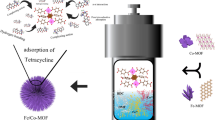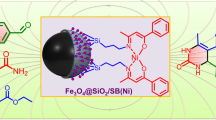Abstract
Curcumin and its different mixed ligand chelates with boron (B-Curc) can be reduced at the mercury drop electrode. The reduction takes place at the enolic C-atom, which is also a part of the chelate ring. Contrary to the known shift of potential towards negative direction concerned with the reduction of the central atom, a shift of the half wave potential towards more positive direction in connection with the reduction of the ligand has been observed. The shift is found to increase with increasing stability of the chelate. On the basis of this observation the stability constants of several mixed ligand B-Curc chelates have been determined, which cannot be obtained with the help of other known methods. From the adsorption prepeak of curcumin, it is possible to ascertain the conformation of the reduced curcumin molecule in the adsorbed state.
Zusammenfassung
Curcumin und Curcuminatoborchelate (B-Curc) mit verschiedenen Zweitliganden lassen sich an der Quecksilbertropfelektrode reduzieren. Die Reduktion erfolgt am enolischen C-Atom, das auch Bestandteil des Chelatringes ist. Im Gegensatz zu der bekannten negativen Potentialverschiebung bei Reduktion des Zentralatoms erfolgt bei Ligandenreduktion eine Verschiebung zu positiveren Halbstufenpotentialen mit zunehmender Stabilität der Chelate. Auf diese Weise wurden Stabilitätskonstanten einiger Gemischtliganden B-Curc-Chelate bestimmt, die mit anderen Methoden nicht erhalten werden konnten. Aus einer Adsorptionsvorstufe ließen sich Aussagen über die Konformation eines reduzierten Curcuminmoleküls im adsorbierten Zustand machen.
Similar content being viewed by others
Literatur
Asmus, E., Hinz, U., Ohls, K., Richly, W.: diese Z.178, 104 (1960)
Brdička, R.: Collect. Czechoslov. Chem. Commun.12, 522 (1947)
Lingane, I. I.: Chem. Rev.29, 1 (1941)
Spicer, G. S., Strickland, I. D.: Anal. Chim. Acta18, 231 (1958)
Author information
Authors and Affiliations
Additional information
Wir danken der Deutschen Forschungsgemeinschaft, Bonn-Bad Godesberg, dem Minister für Wissenschaft und Forschung des Landes Nordrhein-Westfalen, Landesamt für Forschung, sowie dem Verband der Chemischen Industrie, Fonds der Chemie, für Sachbeihilfen.
Rights and permissions
About this article
Cite this article
Quint, P., Umland, F. & Sommer, H.D. Zusammenhang zwischen Chelatstabilität und Redoxpotential des Liganden bei Curcuminato-Bor-Gemischtligandenkomplexen. Z. Anal. Chem. 285, 356–358 (1977). https://doi.org/10.1007/BF00561161
Received:
Issue Date:
DOI: https://doi.org/10.1007/BF00561161




